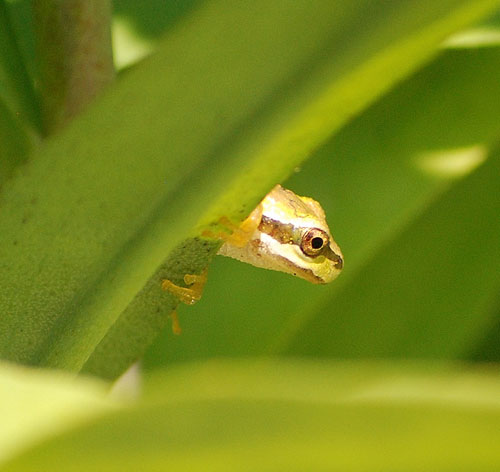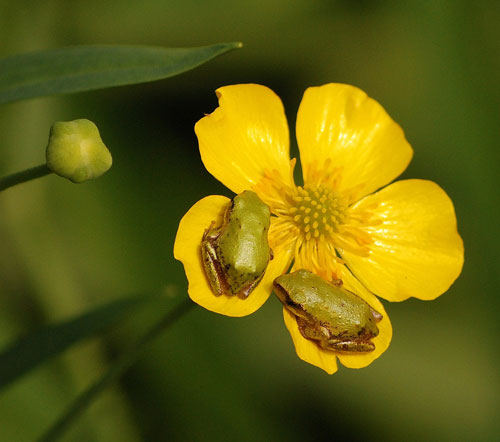The Pacific Treefrog (Hyla regilla) is a very appealing little frog, and quite common in B.C. They are small frogs, up to 5 centimetres long, and may be any colour from pale grey or tan to bronze or bright emerald green. Pacific Treefrogs have a conspicuous dark “mask” or stripe extending from the nostrils through the eye as far as the shoulder. They are often marked with dark patches or stripes on the back, and are usually pale cream underneath. Their legs are long and slender; their toes have round pads, which help the frog grip and climb, and there is very little webbing between the toes, making them look quite long. Females are slightly larger than males, a feature common to most frogs. Any treefrog found in the southern part of the province is almost certain to be a Pacific Treefrog.
The Pacific Treefrog is quite cosmopolitan in its choice of homes. Outside the breeding season, in early spring, Pacific Treefrogs may be found in woodlands, meadows, pastures, and even urban areas, often quite far from the nearest body of water. Coastal residents are often pleasantly surprised to find that a Pacific Treefrog has made itself at home in their garden or in plant pots on the deck. The sticky pads on their toes allow these frogs to climb about on plants with great agility, though they usually stay fairly close to the ground.
During the breeding season, the Pacific Treefrog makes its way to shallow wetlands where there is a lot of plant cover. Often these wetlands or ponds are temporary, drying up by midsummer; they are called “ephemeral” wetlands. By using these wetlands for breeding, the Pacific Treefrog can avoid predatory fish and amphibians, such as Bullfrogs, which require permanent water bodies.
 Early in the spring, Pacific Treefrogs begin to breed. Males make their way to the breeding ponds and call in unison to attract females. The choruses can be startlingly loud considering the size of the frog! The breeding call of the male is a two-syllable krek-ek, instead of the one-syllable c-r-r-ick heard the rest of the year. After mating, the females lay small clusters of eggs, attaching them to bits of vegetation in quiet, shallow water. The egg clusters are irregular in shape and may contain 10 to 70 eggs. The embryos develop rapidly, hatching two or three weeks after the eggs are laid, and the tadpoles metamorphose in approximately two months. Newly metamorphosed Pacific Treefrogs may be only one centimetre long! The young frogs mature quickly and may be ready to breed the year following transformation.
Early in the spring, Pacific Treefrogs begin to breed. Males make their way to the breeding ponds and call in unison to attract females. The choruses can be startlingly loud considering the size of the frog! The breeding call of the male is a two-syllable krek-ek, instead of the one-syllable c-r-r-ick heard the rest of the year. After mating, the females lay small clusters of eggs, attaching them to bits of vegetation in quiet, shallow water. The egg clusters are irregular in shape and may contain 10 to 70 eggs. The embryos develop rapidly, hatching two or three weeks after the eggs are laid, and the tadpoles metamorphose in approximately two months. Newly metamorphosed Pacific Treefrogs may be only one centimetre long! The young frogs mature quickly and may be ready to breed the year following transformation.
Adult Pacific Treefrogs eat spiders and a wide variety of insects, which they hunt while climbing about on plants. Tadpoles graze on algae and detritus. In turn, treefrogs are preyed on by snakes, Bullfrogs, and many birds and mammals, and tadpoles are eaten by larger frogs and fish. (Note: this is why it is so important to keep Bullfrogs off Gabriola Island and ponds free of fish if at all possible)
Pacific Treefrogs can be heard calling throughout the year, especially during rainstorms, and the spring mating choruses are impossible to miss. It’s very difficult to spot these little fellows, though, since they will cease calling if they feel threatened.
 The Pacific Treefrog is quite abundant in B.C. and can use a variety of habitats, so it is not considered to be of conservation concern. Populations may decline in the future, however, if the loss of wetlands continues. Pacific Treefrogs are protected under the British Columbia Wildlife Act.
The Pacific Treefrog is quite abundant in B.C. and can use a variety of habitats, so it is not considered to be of conservation concern. Populations may decline in the future, however, if the loss of wetlands continues. Pacific Treefrogs are protected under the British Columbia Wildlife Act.
Even though Pacific Treefrogs are doing well in B.C., loss of wetland habitats can mean loss of local populations of these tiny frogs. Learn about wetlands and how important they are to our environment.
Take part in BC Frogwatch and let the folks below know when and where you hear treefrogs (and other amphibians) begin their spring chorus. Since the time when frogs begin to call can depend on the weather, scientists think that keeping track of this information may help us learn more about climate change.
No Kidding!
- The Pacific Treefrog can change colour rapidly from light to dark, possibly in response to changes in temperature and humidity.
- The distinctive call of the Pacific Treefrog (especially the mating choruses) is widely used in films for a “tropical” background. Cartoon frogs are often given a Pacific Treefrog voice as well!
- Pacific Treefrogs can throw their voices to some extent, making it quite difficult to close in on a frog by following its call.
Go here: http://www.env.gov.bc.ca/wld/frogwatch/howto/howto.htm to find out more about how to be part of BC Frogwatch
